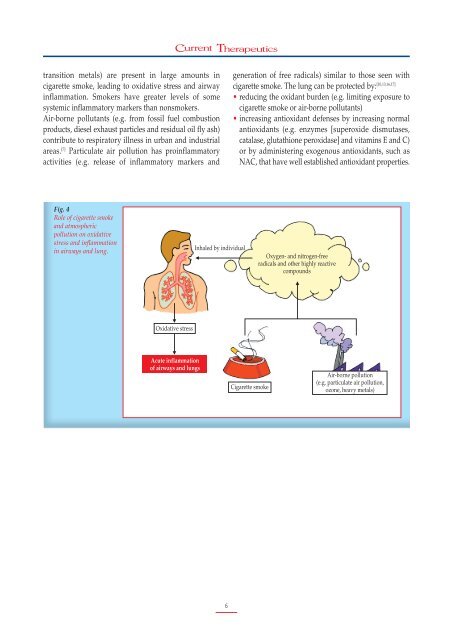Therapeutics
Role of N-Acetylcysteine
Role of N-Acetylcysteine
- No tags were found...
You also want an ePaper? Increase the reach of your titles
YUMPU automatically turns print PDFs into web optimized ePapers that Google loves.
Current <strong>Therapeutics</strong><br />
transition metals) are present in large amounts in<br />
cigarette smoke, leading to oxidative stress and airway<br />
inflammation. Smokers have greater levels of some<br />
systemic inflammatory markers than nonsmokers.<br />
Air-borne pollutants (e.g. from fossil fuel combustion<br />
products, diesel exhaust particles and residual oil fly ash)<br />
contribute to respiratory illness in urban and industrial<br />
areas. [7] Particulate air pollution has proinflammatory<br />
activities (e.g. release of inflammatory markers and<br />
generation of free radicals) similar to those seen with<br />
cigarette smoke. The lung can be protected by: [10,13,16,17]<br />
• reducing the oxidant burden (e.g. limiting exposure to<br />
cigarette smoke or air-borne pollutants)<br />
• increasing antioxidant defenses by increasing normal<br />
antioxidants (e.g. enzymes [superoxide dismutases,<br />
catalase, glutathione peroxidase] and vitamins E and C)<br />
or by administering exogenous antioxidants, such as<br />
NAC, that have well established antioxidant properties.<br />
Fig. 4<br />
Role of cigarette smoke<br />
and atmospheric<br />
pollution on oxidative<br />
stress and inflammation<br />
in airways and lung.<br />
Inhaled by individual<br />
Oxygen- and nitrogen-free<br />
radicals and other highly reactive<br />
compounds<br />
Oxidative stress<br />
Acute inflammation<br />
of airways and lungs<br />
Cigarette smoke<br />
Air-borne pollution<br />
(e.g. particulate air pollution,<br />
ozone, heavy metals)<br />
6


